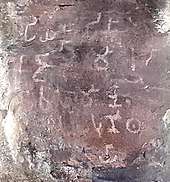Saru Maru
Saru Maru is the archaeological site of an ancient monastic complex and Buddhist caves. The site is located near the village of Pangoraria, Budhani Tehsil, Sehore District, Madhya Pradesh, India.[1][2] The site is about 120 km south of Sanchi.
Saru Maru | |
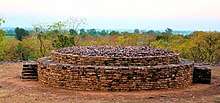 The great stupa of Saru Maru | |
 Shown within India 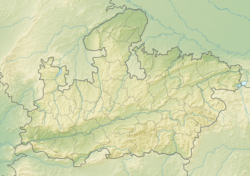 Saru Maru (Madhya Pradesh) | |
| Coordinates | 22.729949°N 77.519910°E |
|---|---|
| Type | Buddhist settlement, stupas and caves |
| Satellite of | Pangoraria |
Description
The site contains a number of stupas as well as natural caves for monks. In the caves many Buddhist graffiti have been found (swastika, triratna, kalasa ...). In the main cave were found two inscriptions of Ashoka: a version of the Minor Rock Edict n°1, one of the Edicts of Ashoka, and another inscription mentioning the visit of Piyadasi (honorific name used by Ashoka in his inscriptions) as Maharahakumara (Prince).[1][2]
The commemorative inscriptionPiyadasi nama/ rajakumala va/ samvasamane/ imam desam papunitha/ vihara(ya)tay(e)
"The king, who (now after consecration) is called "Piyadasi", (once) came to this place for a pleasure tour while still a (ruling) prince, living together with his unwedded consort."
According to the inscription, it would seem that Ashoka visited this Buddhist monastic complex while he was still a prince, and viceroy of the region of Madhya Pradesh, while his residence was to be at Vidisha.[1] In the Buddhist tradition, Ashoka's wife was called Vidishadevi.
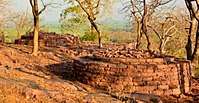 Small stupas on the hill of Saru Maru.
Small stupas on the hill of Saru Maru. An inscription of Ashoka in one of the Saru Maru caves. It is a portion of Minor Rock Edict No.1.[5]
An inscription of Ashoka in one of the Saru Maru caves. It is a portion of Minor Rock Edict No.1.[5]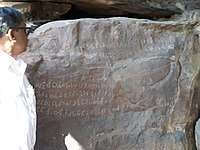 View of the Minor Edicts
View of the Minor Edicts
Full commemorative inscription
| Translation (English) | Transliteration | Transcription (Brahmi script) | Inscription (Prakrit in the Brahmi script) |
|---|---|---|---|
|
|
|
|
References
- Gupta, The Origins of Indian Art, p.196
- Archaeological Survey of India
- Allen, Charles (2012). Ashoka: The Search for India's Lost Emperor. Little, Brown Book Group. pp. 154–155. ISBN 978-1-4087-0388-5.
- Falk, Harry. The Preamble at Panguraria. p. 119.
- Sircar, D. C. (1979). Asokan studies. Plate XVI.
- Allen, Charles (2012). Ashoka: The Search for India's Lost Emperor. Little, Brown Book Group. pp. 154–155. ISBN 9781408703885.
External links
| Edicts of Ashoka (Ruled 269–232 BCE) | |||||
| Regnal years of Ashoka |
Type of Edict (and location of the inscriptions) |
Geographical location | |||
| Year 8 | End of the Kalinga war and conversion to the "Dharma" | 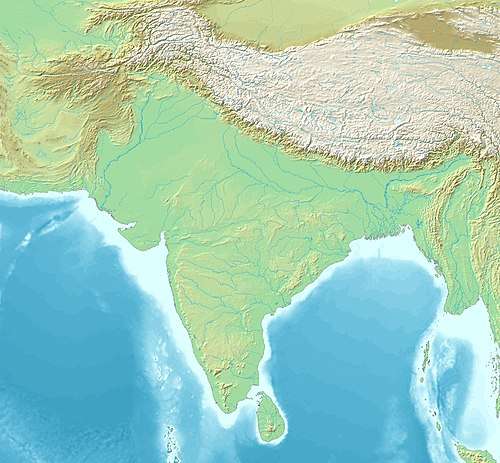 Udegolam Nittur Brahmagiri Jatinga Rajula Mandagiri Yerragudi Sasaram Barabar Kandahar (Greek and Aramaic) Kandahar Khalsi Ai Khanoum (Greek city) | |||
| Year 10[1] | Minor Rock Edicts | Related events: Visit to the Bodhi tree in Bodh Gaya Construction of the Mahabodhi Temple and Diamond throne in Bodh Gaya Predication throughout India. Dissenssions in the Sangha Third Buddhist Council In Indian language: Sohgaura inscription Erection of the Pillars of Ashoka | |||
| Kandahar Bilingual Rock Inscription (in Greek and Aramaic, Kandahar) | |||||
| Minor Rock Edicts in Aramaic: Laghman Inscription, Taxila inscription | |||||
| Year 11 and later | Minor Rock Edicts (n°1, n°2 and n°3) (Panguraria, Maski, Palkigundu and Gavimath, Bahapur/Srinivaspuri, Bairat, Ahraura, Gujarra, Sasaram, Rajula Mandagiri, Yerragudi, Udegolam, Nittur, Brahmagiri, Siddapur, Jatinga-Rameshwara) | ||||
| Year 12 and later[1] | Barabar Caves inscriptions | Major Rock Edicts | |||
| Minor Pillar Edicts | Major Rock Edicts in Greek: Edicts n°12-13 (Kandahar) Major Rock Edicts in Indian language: Edicts No.1 ~ No.14 (in Kharoshthi script: Shahbazgarhi, Mansehra Edicts (in Brahmi script: Kalsi, Girnar, Sopara, Sannati, Yerragudi, Delhi Edicts) Major Rock Edicts 1-10, 14, Separate Edicts 1&2: (Dhauli, Jaugada) | ||||
| Schism Edict, Queen's Edict (Sarnath Sanchi Allahabad) Lumbini inscription, Nigali Sagar inscription | |||||
| Year 26, 27 and later[1] |
Major Pillar Edicts | ||||
| In Indian language: Major Pillar Edicts No.1 ~ No.7 (Allahabad pillar Delhi pillar Topra Kalan Rampurva Lauria Nandangarh Lauriya-Araraj Amaravati) Derived inscriptions in Aramaic, on rock: | |||||
| Wikimedia Commons has media related to Saru Maru. |
